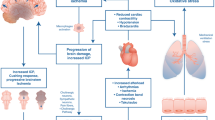Abstract
Glycine has been shown to decrease membrane injury in isolated cells due to hypoxia or cold ischemia. The mechanisms of action of glycine are not known, but glycine may be useful in organ preservation solutions or in treating recipients of liver transplantation. In this study the isolated, perfused rabbit liver was used to measure how glycine affected liver performance after 48-h preservation in University of Wisconsin (UW) solution without added glutathione. UW solution is less effective for 48-h liver preservation when glutathione is omitted. Rabbit livers stored for 48 h without glutathione show a large increase in enzyme release (LDH and AST) from the liver and a reduction in bile production. The addition of 15 mM glycine to UW solution, in place of glutathione, did not improve bile production or reduce enzyme release. However, infusion of 10 mM glycine into the reperfused liver lowered LDH release significantly (from 2383±562 units/100 g to 1426±286 units/100 g) during the initial reperfusion of the 48-h preserved liver. Hepatamine, a parenteral nutrition solution containing glycine, as well as other amino acids, was also effective in lowering LDH release from the preserved liver. Although glycine reduced LDH release, it did not decrease the amount of AST released from the liver, nor did it improve bile production. Thus, we conclude that glycine, either in UW solution or given to the liver upon reperfusion, has no significantly beneficial effect as tested in this model. Further testing of glycine, however, should be conducted in an orthotopic transplant model in the rat or dog.
Similar content being viewed by others
References
Belzer FO, Kalayoglu M, D'Alessandro AM, Pirsch JD, Sollinger HW, Hoffmann R, Boudjema K, Southard JH (1990) Organ preservation: experience with the University of Wisconsin solution and plants for the future. Clin Transplant 4:73–77
Boudjema K, Gulik TM van, Lindell SL, Vreugdenhil PK, Southard JH, Belzer FO (1990) Effect of oxidized and reduced glutathione in liver preservation. Transplantation 50:948–951
Edmondson JW, Bang NU (1980) Deleterious effects of calcium deprivation on freshly isolated hepatocytes. Am J Physiol 241:3–8
Gubernatis G, Dietl KJ, Kemnitz J, Oldhafer K, Hauss J, Buchholz B, Pichlmayr R (1991) Extended cold preservation time (20 hrs 20 min) of a human liver graft by using cardioplegic HTK solution. Transplant Proc 23:2408–2409
Jaeschke H, Smith CV, Mitchell JR (1988) Reactive oxygen species during ischemic-reflow injury in isolated perfused rat liver. J Clin Invest 81: 1240–1246
Jamieson NV, Sundberg R, Lindell SL, Claesson K, Moen J, Vreugdenhil PK, Wight DGD, Southard JH, Belzer FO (1988) Preservation of the canine liver for 24–48 hours using simple cold storage with UW solution. Transplantation 46:517–522
Jamieson JV, Sundberg R, Lindell S, Southard JH, Belzer FO (1988) The isolated perfused rabbit liver as a model for assessment of organ preservation. Transplant Proc 20:996–997
Kalayoglu M, Sollinger HW, Stratta RJ, Southard JH, Belzer FO (1988) Extended preservation of the liver for clinical transplantation. Lancet II: 617–619
Little JR (1964) Determination of water and electrolytes in tissue slices. Anal Biochem 7:87–95
Mangino MJ, Murphy MK, Grabau GG, Anderson CB (1991) Protective effects of glycine during hypothermic renal ischema-reperfusion injury. Am J Physiol 261:F841-F848
Marsh DC, Hjelmhaug JA, Vreugdenhil PK, Belzer FO, Southard JH (1991) Glycine prevention of cold ischemic injury in isolated hepatocytes. Cryobiology 28:105–109
Marsh DC, Vreugdenhil PK, Mack VE, Belzer FO, Southard JH (1992) Glycine protects hepatocytes from injury caused by anoxia, cold ischemia and mitochondrial inhibitors, but not by calcium ionophores or oxidative stress. Hepatology 17:91–98
Marshall VC, Howden BO, Jablonski P, Scott DF, Thomas AS, Cham CW, Biguzas M, Walls K (1990) Analysis of UW solution in rat liver transplant model. Transplant Proc 22:503–505
Orrenius S, McConkey DJ, Bellomo G, Nicotera P (1989) Role of Ca in toxic cell killing. Trends Pharmacol Sci 10: 281–285
Southard JH, Butter G den, Marsh DC, Lindell SL, Belzer FO (1991) The role of oxygen free radicals in organ preservation. Klin Wochenschr 69:1073–1076
Sumimoto R, Jamieson NV, Kobayashi T, Fukada Y, Dohi Y, Kamada N (1991) The need for glutathione and allopurinol in HC solution for rat liver preservation. Transplantation 52:565–567
Sumimoto R, Lindell SL, Southard JH, Belzer FO (1992) A comparison of histidine-lactobionate and UW solution in 48-hour dog liver preservation. Transplantation 54:610–614
Todo S, Nery J, Yanaga K, Starzl TE (1989) Extended preservation of human liver grafts with UW solution. JAMA 261:711–714
Vreugdenhil PK, Marsh DC, Belzer FO, Southard JH (1992) Urea and protein synthesis in cold-preserved isolated hepatocytes. Hepatology 16:241–246
Weinberg JM, Davis JA, Abarzua M, Rajan T (1987) Cytoprotective effects of glycine and glutathione against hypoxic injury to renal tubules. J Clin Invest 80:1446–1454
Weinberg JM, Davis JA, Abarzua M, Kiani T (1989) Relationship between cell adenosine triphosphate and glutathione content and protection by glycine against hypoxic proximal tubule cell injury. J Lab Clin Med 113:612–622
Weinberg JM, Venkatachalam MA, Garzo-Quintero R, Roeser NR, Davis JA (1990) Structural requirements for protection by small amino acids against hypoxic injury in kidney proximal tubules. FASEB 4:3347–3354
Author information
Authors and Affiliations
About this article
Cite this article
den Butter, G., Marsh, D.C., Lindell, S.L. et al. Effect of glycine on isolated, perfused rabbit livers following 48-hour preservation in University of Wisconsin solution without glutathione. Transplant Int 7, 195–200 (1994). https://doi.org/10.1007/BF00327087
Received:
Revised:
Accepted:
Issue Date:
DOI: https://doi.org/10.1007/BF00327087




